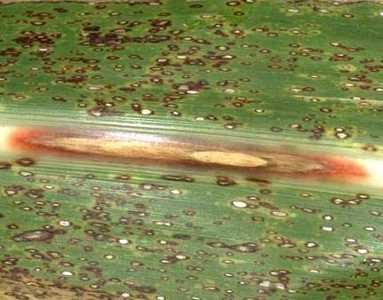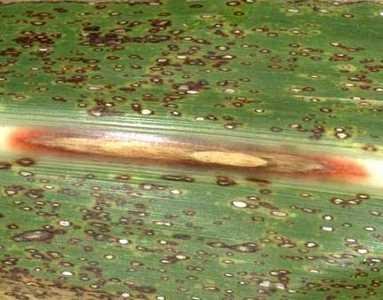

Red rot of sugarcane (Glomerella tucumanensis / Colletotrichum falcatum)
The fungus may infect any part of the sugarcane plant. It is most destructive as a rot of the stalk of standing cane, seed cuttings and/or stubble pieces remaining in the ground after the cane has been harvested. It produces long lesions on the leaf midribs. The lesions on the leaf midribs are dark or red. They may be short and discontinuous or long extending the length of the leaf. The centres become straw-coloured with age and are later covered with black powdery mass of spores of the fungus. However, the leaf lesions cause no serious injury to the plant but are important in the life cycle of the disease because they are sources of the spores that cause infection of the stalk.
Affected plants turn yellow, shrivel and the upper leaves die. On splitting the stalk or seed cutting, the normally white or creamy-white internal tissues are reddened and the reddened area is cross-barred with white or light patches. Any sort of wounding causes a reddening of the stalk tissues next to the wound, but when diseased the characteristic red discolouration extends beyond the point of the wound. In advanced stages of rotting, the interior of the stalk darkens and the tissues shrink, leaving a cavity, which may be filled with mycelium (growth) of the fungus.
The disease is spread by wind and rain. It is also spread by planting infected seed cuttings and it is enhanced by injuries by sugarcane borers and sugarcane weevils.
- Disease management consists of planting disease-free cuttings, resistant varieties and minimising hazards of injury by borers.
- Treatment of the seedlings with a 20-30 minute hot water treatment at 520C can be effective.
For more information on Hot-water treatment click here.
